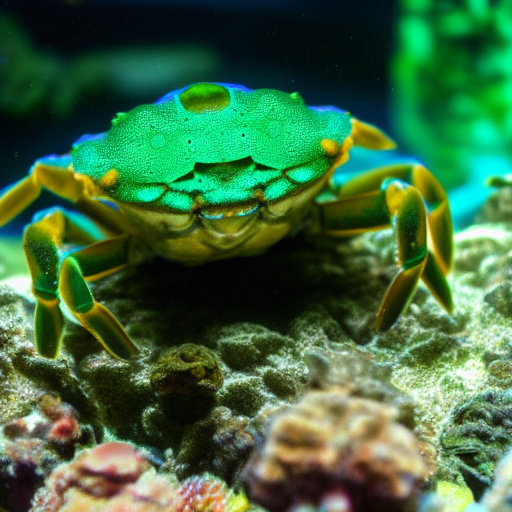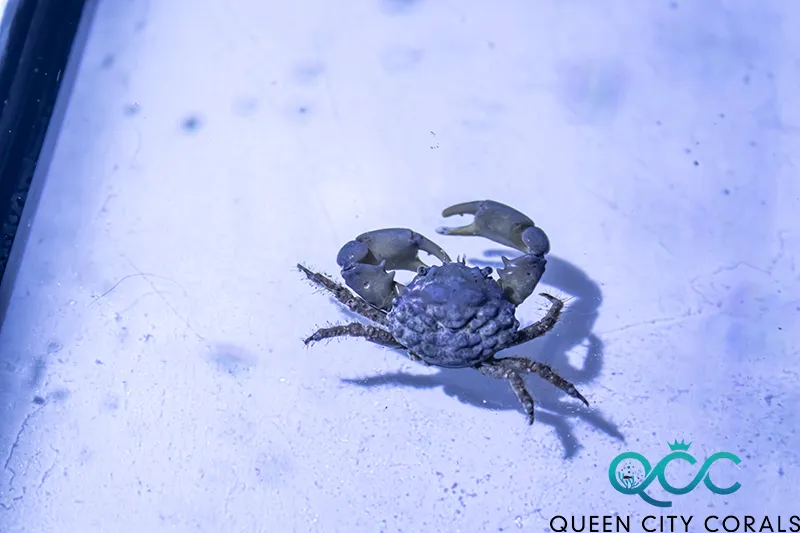Chalice Coral: A Comprehensive Guide for Beginners
Corals are not just beautiful creatures that add color to an underwater world, but they also play a vital role...
Jim Sabellico
September 15, 2022

72°F to 82°F
8.0 to 8.4
8 to 12 dKH
Mithrax sculptus
10 gallon
Easy-Medium
If you’re looking for a comprehensive guide on Emerald Crab care, you’ve come to the right place. In this guide, we will discuss everything from how to set up your aquarium for Emerald Crabs, to the best ways to feed them and keep them healthy.
Emerald Crabs can make a great addition to any saltwater tank, they are known for their ability to help keep algae under control, but it’s important to provide them with the right environment and diet in order to ensure their health and happiness.
Emerald crabs originated from the tropical Caribbean reefs or the Gulf of Mexico, but they have since become a common sight in aquariums all over the world. These small crabs are usually bright green or greenish-brown and can be distinguished by their two large claws. They are generally considered to be a good choice for an aquarium because they are peaceful, scavenge well, and tolerate a wide range of water conditions.
A single crab can be kept in an aquarium as small as 10 gallons, but you’ll need to increase the size of your tank if you want to keep more than one crab. It’s also important to provide plenty of hiding places since emerald crabs are timid creatures that like to feel safe. Live rock caves and coral skeletons make great hiding spots for these little guys!
Yes, emerald crabs are a popular choice for reef aquariums because they are generally considered to be safe for most fish.
Emerald crabs are a hardy species that can live for 2-4 years with proper care.
When it comes to choosing tank mates for an emerald crab, it’s important to consider both the crab’s diet and its temperament. Emerald crabs are scavengers that primarily eat algae, so it’s important to choose tank mates that won’t compete with the crab for food.
Good choices include other algae-eating species like nerite snails and hermit crabs. It’s also important to choose peaceful fish that won’t harass the emerald crab. Good examples include small dartfish and gobies. In general, it’s best to avoid aggressive fish like hawkfish. By following these guidelines, you can ensure that your emerald crab will have a happy and healthy home.
Emerald crabs will molt about once per year, but they are capable of doing it up to 20 times. During the molting process, the emerald crab will leave behind an empty shell and hide for several days or within a week.
They do this because they’re vulnerable with their new shells being soft. While hiding, the crab will Pump out excess water from their gills To make the new shell harden faster. Once the new shell has hardened, the crab will return to its normal activities.
If you want to know about the diet of emerald crabs specifically, they are scavengers that feed on hair algae and bubble algae. In the wild, they help to control the growth of these types of algae in coral reef ecosystems. Meanwhile, in a reef tank, they can be a valuable asset in keeping your tank clean and pushing back the growth of undesirable algae.
Emerald crabs are not particular about what they eat and will pretty much consume anything in their path. In addition to hair algae and bubble algae, they will also munch on detritus, leftovers from fish meals, and virtually anything else they can find. While this cleaning behavior can be beneficial for your aquarium, it’s important to make sure that your crab is getting enough to eat.
To supplement their diet, you can offer them dried seaweed or algae sheets. You can also offer them frozen foods like mysis shrimp or brine shrimp. Emerald crabs are not known to be picky eaters, so they will usually accept whatever food you offer them.
Emerald crabs thrive in warm waters, as they live in shallower waters in the wild. For this reason, it’s important to keep their tank temperature at a steady 70-78 degrees Fahrenheit. Make sure to also provide a good amount of filtration and plenty of rocks and caves for them to hide in, as they like to burrow. As for water parameters, aim for a pH of 8.0-8.4 and a water hardness of 10-20 dGH.

There are a number of online stores that sell Emerald Crabs, but Queen City Corals is a good place to buy emerald crabs, which typically cost between $10 and $20. You have the option to choose quantity when purchasing between 2-pack or single order.
By following the care guidelines outlined above, you can provide your emerald crab with everything it needs to thrive in your reef tank! These easy-to-care-for animals make a great addition to any reef tank and are sure to delight you with their curious personalities and vibrant colors.

I am the founder of J. Louis, a digital marketing agency focused on providing innovative solutions and strategies built on a foundation of creative design and technology. A family man who loves travel and reef tanks, I’ve been coined as a jack of all trades, master of a few of them, most specifically website and sales funnel design, monetization and growth strategies, and viral marketing. I began pursuing my passions for business by cutting my neighbor’s lawns when I was just 8 years old and never looked back. Over the past 20 years, I have amassed significant experience providing consulting, design and development services for Fortune 500 companies, government, retail, private individuals, and A-list celebrities.
Corals are not just beautiful creatures that add color to an underwater world, but they also play a vital role...
As we move into the new year, it's time to start thinking about what reef tank LED lighting kits will...

Proceeds from all purchases go directly to Great Barrier Reef Foundation and supporting their mission.
Want to stay connected with all the latest news in the Reef Tank Addict community? Drop your email below!
Proudly Supporting The Great Barrier Reef Foundation
Copyright © 2023. All rights reserved.